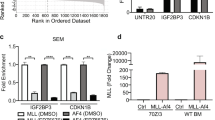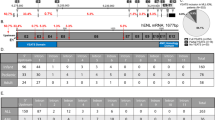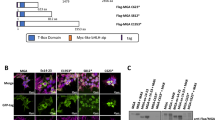Abstract
Members of the TALE (three-amino-acid loop extension) family of atypical homeodomain-containing transcription factors are important downstream effectors of oncogenic fusion proteins involving the mixed lineage leukemia (MLL) gene. A well-characterized member of this protein family is MEIS1, which orchestrates a transcriptional program required for the maintenance of MLL-rearranged acute myeloid leukemia (AML). TGIF1/TGIF2 are relatively uncharacterized TALE transcription factors, which, in contrast to the remaining family, have been shown to act as transcriptional repressors. Given the general importance of this family in malignant hematopoiesis, we therefore tested the potential function of TGIF1 in the maintenance of MLL-rearranged AML. Gene expression analysis of MLL-rearranged patient blasts demonstrated reduced TGIF1 levels, and, in accordance, we find that forced expression of TGIF1 in MLL-AF9-transformed cells promoted differentiation and cell cycle exit in vitro, and delayed leukemic onset in vivo. Mechanistically, we show that TGIF1 interferes with a MEIS1-dependent transcriptional program by associating with MEIS1-bound regions in a competitive manner and that the MEIS1:TGIF1 ratio influence the clinical outcome. Collectively, these findings demonstrate that TALE family members can act both positively and negatively on transcriptional programs responsible for leukemic maintenance and provide novel insights into the regulatory gene expression circuitries in MLL-rearranged AML.
This is a preview of subscription content, access via your institution
Access options
Subscribe to this journal
Receive 12 print issues and online access
$259.00 per year
only $21.58 per issue
Buy this article
- Purchase on Springer Link
- Instant access to full article PDF
Prices may be subject to local taxes which are calculated during checkout








Similar content being viewed by others
References
Daser A, Rabbitts TH . The versatile mixed lineage leukaemia gene MLL and its many associations in leukaemogenesis. Semin Cancer Biol 2005; 15: 175–188.
Slany RK . The molecular biology of mixed lineage leukemia. Haematologica 2009; 94: 984–993.
Horton SJ, Grier DG, McGonigle GJ, Thompson A, Morrow M, De Silva I et al. Continuous MLL-ENL expression is necessary to establish a ‘Hox Code’ and maintain immortalization of hematopoietic progenitor cells. Cancer Res 2005; 65: 9245–9252.
Ferrando AA, Armstrong SA, Neuberg DS, Sallan SE, Silverman LB, Korsmeyer SJ et al. Gene expression signatures in MLL-rearranged T-lineage and B-precursor acute leukemias: dominance of HOX dysregulation. Blood 2003; 102: 262–268.
Armstrong SA, Staunton JE, Silverman LB, Pieters R, Boer den ML, Minden MD et al. MLL translocations specify a distinct gene expression profile that distinguishes a unique leukemia. Nat Genet 2002; 30: 41–47.
Li Z, Zhang Z, Li Y, Arnovitz S, Chen P, Huang H et al. PBX3 is an important cofactor of HOXA9 in leukemogenesis. Blood 2013; 121: 1422–1431.
Wong P, Iwasaki M, Somervaille TCP, So CWE, So CWE, Cleary ML . Meis1 is an essential and rate-limiting regulator of MLL leukemia stem cell potential. Genes Dev 2007; 21: 2762–2774.
Kumar AR, Li Q, Hudson WA, Chen W, Sam T, Yao Q et al. A role for MEIS1 in MLL-fusion gene leukemia. Blood 2009; 113: 1756–1758.
Faber J, Krivtsov AV, Stubbs MC, Wright R, Davis TN, van den Heuvel-Eibrink M et al. HOXA9 is required for survival in human MLL-rearranged acute leukemias. Blood 2009; 113: 2375–2385.
Thorsteinsdottir U, Kroon E, Jerome L, Blasi F, Sauvageau G . Defining roles for HOX and MEIS1 genes in induction of acute myeloid leukemia. Mol Cell Biol 2001; 21: 224–234.
Zeisig BB, Milne T, García-Cuéllar MP, Schreiner S, Martin ME, Fuchs U et al. Hoxa9 and Meis1 Are key targets for MLL-ENL-mediated cellular immortalization. Mol Cell Biol 2003; 24: 617–628.
Dubourg C, Bendavid C, Pasquier L, Henry C, Odent S, David V . Holoprosencephaly. Orphanet J Rare Dis 2007; 2: 8.
Wotton D, Lo RS, Swaby LA, Massagué J . Multiple modes of repression by the Smad transcriptional corepressor TGIF. J Biol Chem 1999; 274: 37105–37110.
Bartholin L, Powers SE, Melhuish TA, Lasse S, Weinstein M, Wotton D . TGIF inhibits retinoid signaling. Mol Cell Biol 2006; 26: 990–1001.
Bertolino E, Reimund B, Wildt-Perinic D, Clerc RG . A novel homeobox protein which recognizes a TGT core and functionally interferes with a retinoid-responsive motif. J Biol Chem 1995; 270: 31178–31188.
Yang Y, Hwang CK, D'Souza UM, Lee SH, Junn E, Mouradian MM . Three-amino acid extension loop homeodomain proteins Meis2 and TGIF differentially regulate transcription. J Biol Chem 2000; 275: 20734–20741.
Seo SR, Lallemand F, Ferrand N, Pessah M, L'hoste S, Camonis J et al. The novel E3 ubiquitin ligase Tiul1 associates with TGIF to target Smad2 for degradation. EMBO J 2004; 23: 3780–3792.
Wotton D, Knoepfler PS, Laherty CD, Eisenman RN, Massagué J . The Smad transcriptional corepressor TGIF recruits mSin3. Cell Growth Differ 2001; 12: 457–463.
Wotton D, Lo RS, Lee S, Massagué J . A Smad transcriptional corepressor. Cell 1999; 97: 29–39.
Melhuish TA, Wotton D . The interaction of the carboxyl terminus-binding protein with the Smad corepressor TGIF is disrupted by a holoprosencephaly mutation in TGIF. J Biol Chem 2000; 275: 39762–39766.
Seo S, Ferrand N, Faresse N, Prunier C, Abecassis L, Pessah M et al. Nuclear retention of the tumor suppressor cPML by the homeodomain protein TGIF restricts TGF-β signaling. Mol Cell 2006; 23: 547–559.
Chen F, Ogawa K, Nagarajan RP, Zhang M, Kuang C, Chen Y . Regulation of TG-interacting factor by transforming growth factor-β. Biochem J 2003; 371: 257.
DiMartino JF, Selleri L, Traver D, Firpo MT, Rhee J, Warnke R et al. The Hox cofactor and proto-oncogene Pbx1 is required for maintenance of definitive hematopoiesis in the fetal liver. Blood 2001; 98: 618–626.
Ficara F, Murphy MJ, Lin M, Cleary ML . Pbx1 regulates self-renewal of long-term hematopoietic stem cells by maintaining their quiescence. Cell Stem Cell 2008; 2: 484–496.
Azcoitia V, Aracil M, Martínez-A C, Torres M . The homeodomain protein Meis1 is essential for definitive hematopoiesis and vascular patterning in the mouse embryo. Dev Biol 2005; 280: 307–320.
Ficara F, Crisafulli L, Lin C, Iwasaki M, Smith KS, Zammataro L et al. Pbx1 restrains myeloid maturation while preserving lymphoid potential in hematopoietic progenitors. J Cell Sci 2013; 126: 3181–3191.
Hisa T, Spence SE, Rachel RA, Fujita M, Nakamura T, Ward JM et al. Hematopoietic, angiogenic and eye defects in Meis1 mutant animals. EMBO J 2004; 23: 450–459.
Hamid R, Brandt SJ . Transforming growth-interacting factor (TGIF) regulates proliferation and differentiation of human myeloid leukemia cells. Mol Oncol 2009; 3: 451–463.
Yan L, Womack B, Wotton D, Guo Y, Shyr Y, Dave U et al. Tgif1 regulates quiescence and self-renewal of hematopoietic stem cells. Mol Cell Biol 2013; 33: 4824–4833.
Yan L, Womack B, Brandt SJ, Hamid R . Transforming growth-interacting factor (TGIF) modulates hematopoietic stem cell functions. ASH Annu Meet Abstr 2011; 118: 1279.
Hamid R, Patterson J, Brandt SJ . Genomic structure, alternative splicing and expression of TG-interacting factor, in human myeloid leukemia blasts and cell lines. Biochim Biophys Acta 2008; 1779: 347–355.
Blank U, Karlsson G, Moody JL, Utsugisawa T, Magnusson M, Singbrant S et al. Smad7 promotes self-renewal of hematopoietic stem cells. Blood 2006; 108: 4246–4254.
Ohlsson E, Hasemann MS, Willer A, Lauridsen FKB, Rapin N, Jendholm J et al. Initiation of MLL-rearranged AML is dependent on C/EBPα. J Exp Med 2014; 211: 5–13.
Karlsson G, Blank U, Moody JL, Ehinger M, Singbrant S, Deng C-X et al. Smad4 is critical for self-renewal of hematopoietic stem cells. J Exp Med 2007; 204: 467–474.
Somervaille TCP, Cleary ML . Identification and characterization of leukemia stem cells in murine MLL-AF9 acute myeloid leukemia. Cancer Cell 2006; 10: 257–268.
Saeed AI, Bhagabati NK, Braisted JC, Liang W, Sharov V, Howe EA et al. TM4 microarray software suite. Meth Enzymol 2006; 411: 134–193.
Subramanian A, Tamayo P, Mootha VK, Mukherjee S, Ebert BL, Gillette MA et al. Gene set enrichment analysis: a knowledge-based approach for interpreting genome-wide expression profiles. Proc Natl Acad Sci USA 2005; 102: 15545–15550.
Zuber J, Rappaport AR, Luo W, Wang E, Chen C, Vaseva AV et al. An integrated approach to dissecting oncogene addiction implicates a Myb-coordinated self-renewal program as essential for leukemia maintenance. Genes Dev 2011; 25: 1628–1640.
Somervaille TCP, Matheny CJ, Spencer GJ, Iwasaki M, Rinn JL, Witten DM et al. Hierarchical maintenance of MLL myeloid leukemia stem cells employs a transcriptional program shared with embryonic rather than adult stem cells. Cell Stem Cell 2009; 4: 129–140.
Cancer Genome Atlas Research Network. Genomic and epigenomic landscapes of adult de novo acute myeloid leukemia. N Engl J Med 2013; 368: 2059–2074.
Rapin N, Bagger FO, Jendholm J, Mora-Jensen H, Krogh A, Kohlmann A et al. Comparing cancer vs normal gene expression profiles identifies new disease entities and common transcriptional programs in AML patients. Blood 2013; 123: 894–904.
Jakobsen JS, Waage J, Rapin N, Bisgaard HC, Larsen FS, Porse BT . Temporal mapping of CEBPA and CEBPB binding during liver regeneration reveals dynamic occupancy and specific regulatory codes for homeostatic and cell cycle gene batteries. Genome Res 2013; 23: 592–603.
Langmead B, Trapnell C, Pop M, Salzberg SL . Ultrafast and memory-efficient alignment of short DNA sequences to the human genome. Genome Biol 2009; 10: R25.
Shen L, Shao N, Liu X, Nestler E . ngs.plot: Quick mining and visualization of next-generation sequencing data by integrating genomic databases. BMC Genom 2014; 15: 284.
Machanick P, Bailey TL . MEME-ChIP: motif analysis of large DNA datasets. Bioinformatics 2011; 27: 1696–1697.
Bagger FO, Rapin N, Theilgaard-Mönch K, Kaczkowski B, Jendholm J, Winther O et al. HemaExplorer: a Web server for easy and fast visualization of gene expression in normal and malignant hematopoiesis. Blood 2012; 119: 6394–6395.
Bagger FO, Rapin N, Theilgaard-Mönch K, Kaczkowski B, Thoren LA, Jendholm J et al. HemaExplorer: a database of mRNA expression profiles in normal and malignant haematopoiesis. Nucleic Acids Res 2013; 41: D1034–D1039.
Ayton PM, Cleary ML . Transformation of myeloid progenitors by MLL oncoproteins is dependent on Hoxa7 and Hoxa9. Genes Dev 2003; 17: 2298–2307.
Faresse N, Colland F, Ferrand N, Prunier C, Bourgeade M, Atfi A . Identification of PCTA, a TGIF antagonist that promotes PML function in TGF-beta signalling. EMBO J 2008; 27: 1804–1815.
Ruscetti FW, Bartelmez SH . Transforming growth factor beta, pleiotropic regulator of hematopoietic stem cells: potential physiological and clinical relevance. Int J Hematol 2001; 74: 18–25.
Quéré R, Karlsson G, Hertwig F, Rissler M, Lindqvist B, Fioretos T et al. Smad4 binds Hoxa9 in the cytoplasm and protects primitive hematopoietic cells against nuclear activation by Hoxa9 and leukemia transformation. Blood 2011; 117: 5918–5930.
Hess JL, Bittner CB, Zeisig DT, Bach C, Fuchs U, Borkhardt A et al. c-Myb is an essential downstream target for homeobox-mediated transformation of hematopoietic cells. Blood 2006; 108: 297–304.
Zeisig BB, Milne T, García-Cuéllar M-P, Schreiner S, Martin ME, Fuchs U et al. Hoxa9 and Meis1 are key targets for MLL-ENL-mediated cellular immortalization. Mol Cell Biol 2004; 24: 617–628.
Berger MF, Badis G, Gehrke AR, Talukder S, Philippakis AA, Peña-Castillo L et al. Variation in homeodomain DNA binding revealed by high-resolution analysis of sequence preferences. Cell 2008; 133: 1266–1276.
Acknowledgements
This study was supported by the Danish Research Council for Medical Research and through a center grant from the NovoNordisk Foundation (The Novo Nordisk Foundation Section for Stem Cell Biology in Human Disease). We thank Anna Fossum for help with cell sorting.
Author information
Authors and Affiliations
Corresponding author
Ethics declarations
Competing interests
The authors declare no conflict of interest.
Additional information
Supplementary Information accompanies this paper on the Leukemia website
Rights and permissions
About this article
Cite this article
Willer, A., Jakobsen, J., Ohlsson, E. et al. TGIF1 is a negative regulator of MLL-rearranged acute myeloid leukemia. Leukemia 29, 1018–1031 (2015). https://doi.org/10.1038/leu.2014.307
Received:
Revised:
Accepted:
Published:
Issue Date:
DOI: https://doi.org/10.1038/leu.2014.307



